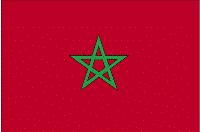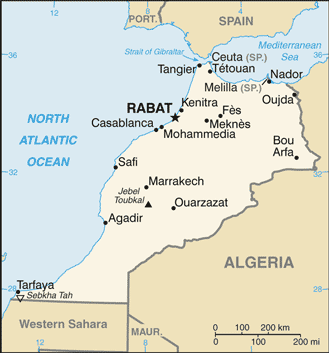Oct 11 2012
Topics Covered
Welcome to Morocco and Western Sahara
Overview of Resources
Industrial Minerals
Metals
Fossil Fuels
Investment
Sources
Welcome to Morocco and Western Sahara
Morocco, with a total population of 32,309,239 as of July 2012, is located in Northern Africa, bordering the North Atlantic Ocean and the Mediterranean Sea, between Algeria and Western Sahara. The country mostly has a Mediterranean climate and covers a total area of 446,550 km2.
 |
The national flag of Morocco.
Image Credit: CIA Factbook. |
Morocco gained independence from France in 1956 after a prolonged struggle. During the late 1970s, Morocco conquered Western Sahara, though a final decision on the status of the territory is yet to take place. Western Sahara is believed to have a large number of phosphate deposits. The Bou Craa mine in Western Sahara contains one of the world’s largest phosphate rock reserves.
In 1999 the country experienced a steady economic growth rate, decline in government debt and low inflation besides developing new methods for infrastructure and industrial development. Poverty and unemployment continued to prevail in the country despite the economic progress in 1999. In 2011, the country’s economic growth rate saw a steep decline due to increase in fuel and food prices. The country’s GDP as of 2011 was $164.7 billion.
To stabilize its economic status, the country will have to reduce government expenditure, address socioeconomic differences, reform the judiciary and educational and construct value-added industries.
Overview of Resources
Morocco’s key natural resources include phosphates, zinc, manganese and iron ore.
The significant structural domains that make up Morocco’s geology are as follows:
- The Rif domain containing traces of tungsten, tin, cobalt, titanium, zinc and antimony.
- The High Atlas domain containing traces of zinc, lead, barite, iron and copper.
- The Anti-Atlas domain containing silver, gold, manganese, tin, cobalt, titanium, zinc and antimony.

The map of Morocco. Image Credit: CIA Factbook
Industrial Minerals
In 2010, the cement industry in Morocco was operated by four companies supported by cement producers from France, Portugal, Switzerland and Italy.
In 2010, the cement sales from Lafarge Ciments, a French company, saw a major decrease due to bad weather conditions but the company coped up thanks to increase in Morocco’s construction activities.
Morocco excelled in its richness of mineral deposits and in 2010 the country was the third leading producer and a leading exporter of phosphate in the world. Almost 27% of the global demand for phosphate was met by Morocco and the country’s mineral industry played a significant role in boosting the national economy thanks to increase in production and export of phosphate.
In 2010, Morocco had about 50Mt phosphate reserves, and Office Chérifien des Phosphates (OCP) was the only phosphate rock producing firm in Morocco.
Metals
In 2010, Morocco’s Anti-Atlas copper-silver district had a high density of copper deposits and Odyssey Resources Ltd. of Canada obtained 34 licenses to explore this district. Unsuccessful exploration results forced Odyssey to announce its decision to stop all exploration activities in Morocco.
The Amizmiz project was an ongoing gold exploration activity in Morocco in 2010. Canada’s Maya Gold and Silver Inc. carried out exploration activities as part of this project.
Morocco’s Tamlait gold deposit was owned by Australia’s Kasbah Resources Ltd. Located about 300 km south of Oujda the Tamlait gold deposit had eight exploration permits and covered a total surface area of 128 km2.
Morocco’s chief silver mines in 2010 include the mines of Société Metallurgique d’Imiter and Igoudrane. The Imiter mines are capable of processing about 500,000 t/yr of ore and the Igoudrane mines are capable of processing 300,000 t/yr of ore.
Through the Achmmach tin project, Kasbah Resources plans to increase the production of tin in the Achmmach Mine by reducing project risks and increasing the size of the resource in the deposit.
In 2010, the Douar Hajar Mine produced metal concentrates comprising 52% zinc, 68% lead and 28% copper. These concentrates were mainly exported to European countries through the Port of Safi.
Fossil Fuels
In 2010, the Moroccan government depended on the imports of coal from the US, South Africa and Colombia. In the same year, drilling of the ADD-1 exploration well took place and was tested to be a potential producer of natural gas.
In 2010, the government had approved the environmental impact assessment carried out for the Tarfaya pilot plant facility. An analysis was also carried out for drilling two wells and also for the availability of Rig.
Uranium exploration was encouraged by the Office National des Hydrocarbures et des Mines (ONHYM). Even though limited number of petroleum reserves was available in morocco in 2010, the country still managed to produce phosphate containing uranium. The government was also planning to build its very first nuclear power plant whose operation will likely commence between 2022 and 2024.
Investment
Morocco hopes to attract international investors and establish global joint ventures through plans to introduce a new mining law in 2013, which will likely boost its mining industry. Experts feel that Morocco has the potential for mining silver, zinc, cobalt and magnesium.
Recent reports on phosphates highlight the fact that the world will soon find itself running out of this commodity. At present about 15% of phosphate is obtained from the mines in Western Sahara and Morocco and the shortage of this will to a large extent affect the agricultural sector of Brazil and India.
The government also hopes to attract international investments to boost its petroleum and naturals gas sectors, introduce new mining reform programs and privatize specific mining assets owned by the state.
In the coming years, the output of zinc, silver and lead is expected to decline due to decrease in the number of reserves. The production of tin will increase only if Kasbah Resources decides to operate the Achmmach Mine.
On the whole, the production of phosphate will continue to dominate Morocco’s mineral industry, and with this increase in phosphate output and developments in the mining and mineral sectors, the country is expected to see a major development in its economic growth rate in the coming years.
Disclaimer: The Author of this article does not imply any investment recommendation and some content is speculative in nature. The Author is not affiliated in any way with any companies mentioned and all statistical information is publically available.
Sources